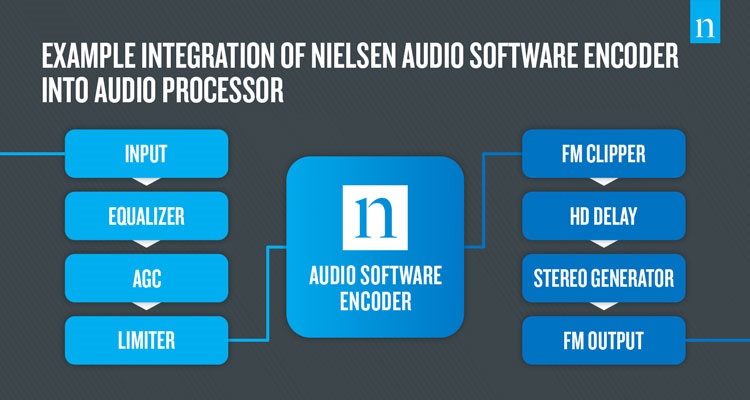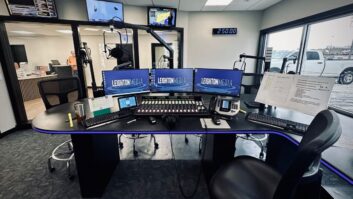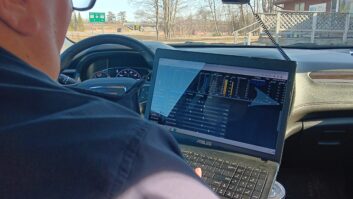
A new Radio World ebook explores “The Software-Based Air Chain.” This is an excerpt.
Nielsen’s Audio Software Encoder decouples the company’s PPM encoding algorithm from the hardware encoder and instead makes it available for integration into third-party broadcasting equipment. When the software is incorporated into a station’s audio processing, it can add the enhanced CBET code to the audio stream.
Nick Mannion is director of product management at Nielsen; he has responsibility for its audio measurement portfolio including the Portable People Meter and diary collection systems.
Radio World: What is Nielsen’s interest in the software-based air chain?
Nick Mannion: First some background. Every station included in PPM measurement gets an encoder that places a watermark in the audio played over the air. Then we recruit a representative sample of panelists who carry around PPM, like the one I’m wearing here on my wrist. It picks up the code, logs it and sends the data back to Nielsen, where it’s tabulated and then projected back out to the population.
Typically, watermarking at the broadcast facility has been done by a piece of hardware that Nielsen — and Arbitron before it — provided to the stations. But working with the NAB Radio Technology Committee and its PPM subcommittee, led by Jason Ornellas of Bonneville, we developed a software encoder that takes the brain out of the hardware and makes it available in a software development kit for any vendor to integrate into their product.
At Nielsen, we’re agnostic on the question of virtualization. Our goal is to measure everybody in PPM markets equally, whether they are virtualized or condense their hardware onto an on-prem server. We need to make sure we’re providing solutions so that they can be measured with that PPM watermark.

RW: The software kit is available to any technology company that wants to integrate it in their product?
Mannion: Essentially yes, with a little bit of paperwork and NDAs. We now have 18 certified integrations including Orban, Omnia and Wheatstone. We have focused on audio processors because PPM typically sits in an air chain near the audio processor. On our engineering portal, stations can see which products are certified for Nielsen PPM encoding.
RW: How does one get certified?
Mannion: A company requests our SDK to integrate into their platform. Nielsen’s engineers work with them to understand what their product does. Then we develop extensive test criteria to make sure the PPM encoding coming out of the product is equivalent to what would come out of a hardware encoder, so that no station has an advantage or disadvantage. We develop a technical requirements document and hundreds of test cases — different ways you can set it up — and we make sure that you can’t, for instance, inadvertently route around the PPM encoding.
Only then do we give them a certification, a license to distribute the Nielsen Audio Software Encoder to radio stations.
RW: What are the most common concerns you hear from stations?
Mannion: This is something new; and when it comes to something like PPM encoding, which is critical for a station’s revenue, some groups or engineers are more hesitant to change than others.
Many prefer to start on their station streams. We measure streams separately from the AM and FM; and we see broadcasters getting comfortable with the software encoder by dipping their toes in first using their streams, before they jump to their big AMs and FMs.
RW: Was it technically difficult to assure that the software iterations were as reliable as the hardware?
Mannion: Not really. We run a battery of tests anytime we make a change in PPM or encoding. At our office in Columbia, Md., we have a critical listening room where we run exhaustive tests across all types of formats, content, processing volumes, background noise, etc.
We make sure the SDK puts out a good robust watermark, then we go through that certification process, looking at an individual product’s integration, including the battery of more than 100 test cases.
After our initial rollout, we also conducted field tests on AM, FM, HD and streams. That data is shared openly with the Media Ratings Council as part of our audit requirements.
Last but not least we have a multi-channel encoding monitor that allows stations to look at the performance of their watermark minute by minute across their day, so they can see they’re getting the same level of performance.
It’s in our best interest as well as the client’s to make sure they have a robust watermark.
RW: How many stations have switched?
Mannion: Around 500 streams in PPM markets have made the switch. Fewer so far on AMs and FMs. As I said, some are kicking the tires right now. But from my time spent at the NAB Show and meeting with various engineering leaders, as they look to virtualize their playout, this is where they are going. There are early adopters, and I think we’ll have a lot of fast followers who are just waiting and see how the early adopters fare before they jump in. That’s true not just in PPM but virtualization as a whole.
RW: What is the potential universe of users? If you put one encoder on every AM signal, every FM signal and every HD multicast, plus every stream version of those signals, that must be 25,000 or 30,000 potential encoder points in the United States.
Mannion: Keep in mind that we measure with PPM in the top 48 markets. At the peak of the hardware encoder, we had about 13,000 pieces of hardware out at stations. Some stations have primary and backup encoders; some have a “doomsday path” to air, for emergencies. But as to the size of the potential universe, I’d say it is around 5,000 stations or streams.
RW: Anything else we should know?
Mannion: The readers of Radio World, particularly readers of this ebook, are the people who are thinking about virtualization and cloud. What I’d like them to know is that Nielsen has options for them today, and that we’re a willing partner to work with them on the future.
Read more about how software is remaking the broadcast air chain in the latest Radio World ebook.











